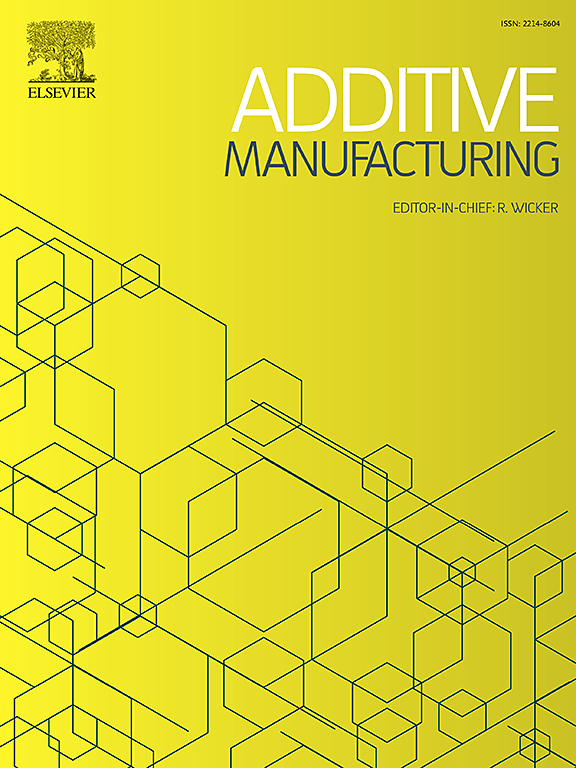Dual-inherent strain method for efficient residual stress prediction in additive manufacturing process
IF 11.1
1区 工程技术
Q1 ENGINEERING, MANUFACTURING
引用次数: 0
Abstract
Accurate and efficient estimation of residual stress and distortion at the design stage remains crucial and challenging, primarily due to the complex and subjective calibrations required by existing modeling methods, hindering their widespread adoption in the additive manufacturing (AM) process. The inherent strain method (ISM) has been widely used due to its proven effectiveness in predicting distortion and for its low computational cost as simulations rely on a single static analysis. Inherent strain is calculated from a meso-scale thermomechanical simulation and applied to a part-scale mechanical simulation, significantly reducing computational time. However, predicting residual stress with conventional ISM requires additional fictious non-physical property modeling, limiting its effectiveness. This study proposes a novel dual-inherent strain method (DISM) for efficient residual stress simulation in additive manufacturing, while retaining the distortion prediction accuracy. The method improves residual stress prediction with a new procedure to calculate and apply strain in part-scale simulations, capturing strain evolution during the AM process without needing calibration in property modeling. The proposed method is validated by experiments conducted on a Ti-6Al-4V double-cantilever beam processed by laser powder bed fusion. Additionally, the proposed approach eliminates the need for calibration of a threshold of fictious non-physical material property used in the conventional ISM, which significantly influences prediction results. On average, the new DISM achieves a 41 % reduction in computational time compared to the conventional ISM. This systematic method is adaptable to different materials and processes without the need for recalibration, making it broadly applicable to various scenarios in additive manufacturing.
增材制造过程中有效残余应力预测的双固有应变法
在设计阶段准确有效地估计残余应力和变形仍然是至关重要和具有挑战性的,主要是由于现有建模方法需要复杂和主观的校准,阻碍了它们在增材制造(AM)过程中的广泛采用。固有应变法(ISM)由于其在预测变形方面的有效性和计算成本低而被广泛应用,因为模拟依赖于单一的静态分析。固有应变由细观尺度热力学模拟计算,并应用于局部尺度力学模拟,大大减少了计算时间。然而,用传统的ISM预测残余应力需要额外的虚构的非物理性质建模,限制了其有效性。本研究提出了一种新的双固有应变法(DISM),用于增材制造中有效的残余应力模拟,同时保持变形预测的准确性。该方法改进了残余应力预测,采用了一种新的方法来计算和应用局部尺度模拟中的应变,在属性建模中无需校准即可捕获增材制造过程中的应变演变。通过激光粉末床熔合Ti-6Al-4V双悬臂梁的实验验证了该方法的有效性。此外,该方法消除了传统ISM中虚构的非物理材料属性阈值的校准需要,而传统ISM对预测结果有很大影响。平均而言,与传统ISM相比,新DISM的计算时间减少了41% %。该系统方法适用于不同的材料和工艺,无需重新校准,广泛适用于增材制造的各种场景。
本文章由计算机程序翻译,如有差异,请以英文原文为准。
求助全文
约1分钟内获得全文
求助全文
来源期刊

Additive manufacturing
Materials Science-General Materials Science
CiteScore
19.80
自引率
12.70%
发文量
648
审稿时长
35 days
期刊介绍:
Additive Manufacturing stands as a peer-reviewed journal dedicated to delivering high-quality research papers and reviews in the field of additive manufacturing, serving both academia and industry leaders. The journal's objective is to recognize the innovative essence of additive manufacturing and its diverse applications, providing a comprehensive overview of current developments and future prospects.
The transformative potential of additive manufacturing technologies in product design and manufacturing is poised to disrupt traditional approaches. In response to this paradigm shift, a distinctive and comprehensive publication outlet was essential. Additive Manufacturing fulfills this need, offering a platform for engineers, materials scientists, and practitioners across academia and various industries to document and share innovations in these evolving technologies.
 求助内容:
求助内容: 应助结果提醒方式:
应助结果提醒方式:


